Solar Bluetooth GPS Receiver Review
 This year at CeBIT there was one GPS receiver that – undeservedly - got not much press coverage. Recently we have had the chance to test the Solar Bluetooth GPS Receiver, just in time now that it has started to hit the shelves both in Europe ( www.starnavigation.de ) and in the US ( www.semsons.com ) and probably in a number of other countries, under a variety of names. Have a read and see if this innovative product is something you want to consider as your next receiver.
Special thanks go to fTech, Taiwan (http://www.f-tech.com.tw/Eng/Index.htm) for providing the review unit (they call it "GPS Receiver version 2.0, Solar 7")
This year at CeBIT there was one GPS receiver that – undeservedly - got not much press coverage. Recently we have had the chance to test the Solar Bluetooth GPS Receiver, just in time now that it has started to hit the shelves both in Europe ( www.starnavigation.de ) and in the US ( www.semsons.com ) and probably in a number of other countries, under a variety of names. Have a read and see if this innovative product is something you want to consider as your next receiver.
Special thanks go to fTech, Taiwan (http://www.f-tech.com.tw/Eng/Index.htm) for providing the review unit (they call it "GPS Receiver version 2.0, Solar 7")
What's in the box?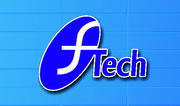
You get the receiver, a CD with the user guide and some test programs, and a mains charger with a mini-USB connector. Some packages also contain a mobile charger consisting of a cigarette lighter USB adapter and a USB-mini USB cable that you can also use with your notebook or desktop (unfortunately only to charge the device). Make sure you ask for the mobile charger version.
The exterior
The receiver is pretty big, about twice the size of a Globalsat BT-338 (we'll use the BT-338 also for the performance comparison). This is easy to explain since you need to place the solar cell and the GPS ceramic patch antenna side by side (anyone who invents a solar cell that allows GPS signals through – here's your business idea…)

 Two clear plastic inlays wrap from the top over to the side, allowing the status LEDs to be seen both from top and from the side.
Two clear plastic inlays wrap from the top over to the side, allowing the status LEDs to be seen both from top and from the side.
On the “short” side you find the software on/off button (which means hard wiring the receiver into the car is not seamless - you 'll have to press a button to switch the receiver on).
Next is a Mini USB socket which is disappointingly only providing the charging power to the receivers battery – if you connect the provided USB cable to your desktop or notebook then you only get an “unrecognized device” message. It would have been a nice touch to actually be able to use the receiver via USB. I am not sure why a mini USB socket was selected - the standard round socket like on the majority of the devices would have made more sense.
The USB socket is normally protected by a rubber cover (not shown here). The same is true for the MMCX connector on the “long” side – this one allows you to connect an external antenna in case you have a coated windshield (just wondering – doesn't that also affect the solar cell?).
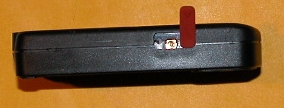
At the bottom of the receiver is the battery compartment, holding a standard 900 mAh rechargeable/replaceable battery. There is also a little magnet hidden below the rubber feet so you can attach the receiver to your car roof.or any other metallic surface. This also comes in handy when you want to position the solar cell towards the sun.
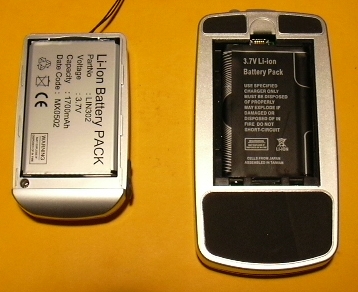
Despite the two rubber covers the receiver is not watertight but it should be able to endure a splash or two.

The case of the receiver comes in a number of variations – black, blue, red, and silver. I do very much doubt that black is a smart choice, especially when you think where the receiver should be – right, in direct sunlight. There is even a funny phrase in the user guide –
“The receiver is made by high-technology electronic components. Please do not make it
exposed in sunshine for a long time.”
Doh! In any case I recommend you go for the silver version. It should be able to resist the intense heat in the front area of the wind screen better than the other versions. Be aware though that there still is a risk involved - the rechargeable battery itself . It can explode when it gets too hot. I will expose the unit to the mercyless Texas summer and will let you know if I had to buy a new car.
.
If your car has a coated windscreen then you ill have to find a different location. If you ar not too forgetful and if the weather is right you can even place the receiver on the roof of the car. The magnet is strong enough to hold the receiver, even when you change speeds hectically while approaching the next speed, uhm, safety camera.
Power consumption
 The advertisement for the receiver claims things like “you never need to charge your receiver again” etc. Yeah right. Here's the true story. The GPS and Bluetooth circuits require a combined 45 mA (milli-Ampere). This means the standard 900 mAh battery can power the unit for roughly 20 hours.
The advertisement for the receiver claims things like “you never need to charge your receiver again” etc. Yeah right. Here's the true story. The GPS and Bluetooth circuits require a combined 45 mA (milli-Ampere). This means the standard 900 mAh battery can power the unit for roughly 20 hours.
That in itself is pretty impressive and it is so thanks to the low power Xemics chipset (XE1610) based on the latest Trimble FirstGPS technology – more details can be found here.
For comparison – the BT-338 pulls around 15 hours from its huge 1700 mAh battery.
The solar battery can contribute something like 15 mA to the overall power. This means the receiver only needs to draw 30 mA from the rechargeable battery, and can therefore theoretically run for 30 hours, assuming the sun is shining all the time, day and night. Hum, something's not sound here… If I just knew what … ;-)
This also means that if you want to run your receiver exclusively from the solar battery then you can use it only one third of the time it is exposed to the sunlight. To completely recharge an empty receiver with just the solar battery takes 60 hours – five days if you assume 12 hours of sunshine each day and the receiver always being in optimal reception. This is highly unlikely, so don't throw that USB charging cable away just yet.
If the receiver power dies on you in the middle of nowhere you will be able to use it but have to be very economical at that. Expose it to sunlight for three hours and you may get an hour of usage out of it which will hopefully be enough to get you out of the “I'm lost and the only living thing in proximity is that bear on the other side of the slope” scenario.
So no, the receiver is not as self sustaining as the advertisement suggests, but it can still save you out of a miserable situation assuming you're not trapped in a sun-less area.
Power Save
Like the BT-338 which switches off after 10 minutes when no Bluetooth connection is active the Solar Receiver has a similar feature – it switches off after roughly 25 minutes of not being used. For whatever reason this – valuable – feature is not mentioned in the user guide.
Setup
The Solar BT GPS receiver is very easy to setup. In fact, there's not much setup you can actually do since none of the GPS tools is able to send the NMEA commands back to the receiver with the manufacturer specific prefix (XEM in this case) . There is a GPSViewer program for the PDA (described later) but it doesn't seem to be able to configure the receiver. So you're pretty much stuck with what the receiver is setup from the factory. This is GGA, GSA, GSV, and RMC, all sent once a second.
If your program needs VTG or GLL then this receiver is not for you. Similarly there is no way to set SBAS (the chipset claims to support that) or trickle power mode (which probably doesn't make sense here anyhow)
The user guide says to set the speed to 9600 but like any regular Bluetooth chipset the one used here will auto-sense whatever speed you have specified, from 2400 up to 57600. We always recommend using 38400 for Bluetooth receivers.
You don't need to bond the receiver with Pocket PCs, for all other devices use the standard bonding code 0000. One small problem is the name of the device - it announces itself as "BT GPS" which is not very helpful when you have multiple devices with that name.
Performance
The Xemics chipset has the advantage of a very low power consumption of 45 mA – as a comparison the BT-338 draws about 120 mA. But this low consumption also comes at a price – the Xemics chipset has only 8 receiving channels, and therefore can only track a maximum of 8 satellites, and those only with straight signals (the BT-338 has 20 channels which it also uses to track bounced multipath signals).
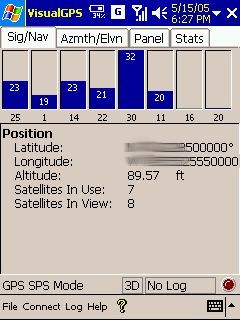

Left: Solar receiver Right: BT-338
Consequently performance is a little bit inferior. With clear sky view (actually this was only a view onto half the sky) the difference is not too big – both receivers lock on to the same number of satellites, with roughly the same signal-to-noise ratio (SNR). But as soon as conditions deteriorate (tinted windscreen, or indoors) the solar receiver loses the fix and does not regain it any more. At the same time the BT-338 keeps its lock on 8 satellites.
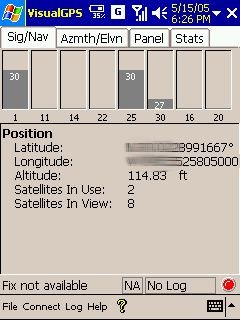
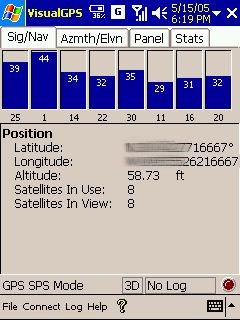
These tests were by no means scientific (I have only one Pocket PC and could not record the screenshots simultaneously), but you can certainly see and feel the difference in performance. Again - not a big issue outdoors with a good sky view.
Design oddities
As with nearly every manufacturer this receiver also does not comply to the design guidelines for warning lights. It's LEDs are blinking all the time, except when they should be (when the receiver has no fix). In addition the red LED signifies the GPS status while the green LED shows the charging status… To add insult to injury the green LED starts blinking when the power is low, and it keeps blinking and blinking until the power is REALLY low. You can't even stop it from blinking by switching the unit off.
I would strongly recommend to rethink the functionality of each LED:
Blue - blinking without BT connection, solid with BT connection
Green - blinking when no GPS fix, solid with fix
Red - solid when charging off mains, blinking at low battery (but not when the unit is switched off)
Recession – The solar cell is very far recessed into the body (about 5 millimeters) – that is unfortunate as it wastes valuable light entry areas and greatly reduces the effectiveness of the solar cell. It would have been better if the cell would have been flush with the receiver body.
The other extreme is the software power button. It protrudes from the case quite a bit and can be pressed accidentally when in the pocket etc. Again, making the button flush with the body would have helped.
Remodeling
This is the “Do NOT Try This At Home” area. As always we're taking a look under the hood, and we are looking for ways to improve the receiver. We used a black preproduction model for these modifications.
As mentioned above there's a lot of air in between the solar cell and the case. Even worse, about one third of the solar cell is covered by the case, decreasing the efficiency.
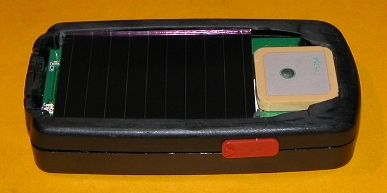
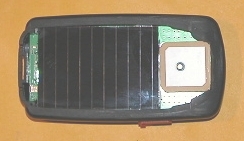
So I took a fine saw and cut the case off. I eventually did fit a clear piece of plastic back on, but it still looks pretty cool and geeky…
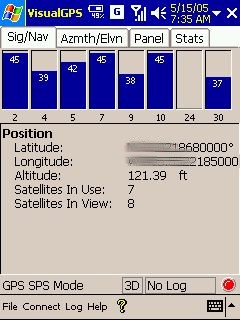 The whole solar cell now has a good chance to catch some sun, and the GPS reception has seemingly increased a bit, too. I was pleased to see that the silver production model did also expose more of the solar cell by dropping the black frame from the clear plastic cover, however that still leaves the issue of the recession.
The whole solar cell now has a good chance to catch some sun, and the GPS reception has seemingly increased a bit, too. I was pleased to see that the silver production model did also expose more of the solar cell by dropping the black frame from the clear plastic cover, however that still leaves the issue of the recession.
As an additional bonus the LEDs are now better readable in direct sunlight, although a tad too bright at night...
The software power button was also cut to be flush with the case – this still allows you to press it, but no longer will it happen accidentally.
The Software
The CD comes with a PDA program and a PC program to test the receiver. As already mentioned above these programs fail to comprehend that this is a Xemics chipset, which cannot be programmed with $PSRF commands, and rather needs $PXEM commands. Hopefully this can be corrected with new versions of the software.
"Recoder" is actually a typo and should say "Recorder" - it allows you to log the NMEA sequences into a text file.
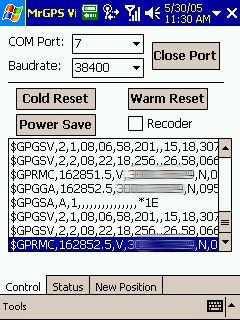
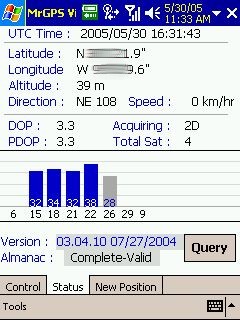
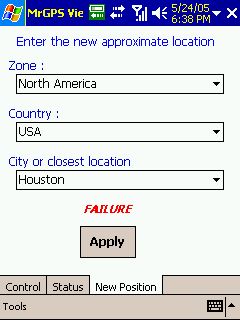
The PC program is useless when you are using the Windows XP SP2 Bluetooth stack as it only allows to connect COM ports from COM1 to COM10, and the Bluetooth software will invariably assign ports like COM13 or COM37. But even with the WidComm stack the program is of little use since it tries to send SiRF setup commands to a Xemics chipset... Fortunately you do not really need either program.
Conclusion
The Solar Bluetooth GPS Receiver is a welcome innovation, pushing the boundaries of mobile navigation at least a little bit.
The emphasis on power saving brings with it some reduction in performance, but it also increases the battery runtime substantially. I am sure future versions of solar GPS receivers will implement even more power saving features, and we will soon see truly self sufficient devices.
Until then the Solar Bluetooth GPS receiver is worth considering if you are in the market for an average performer at an attractive price and with the bonus of an additional power source.. If you want superior performance and are willing to pay the premium then go for the BT-338 or any of the other SiRF III receivers.